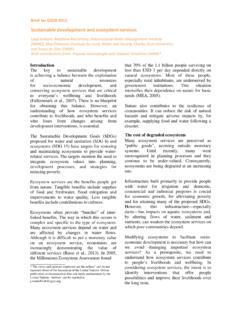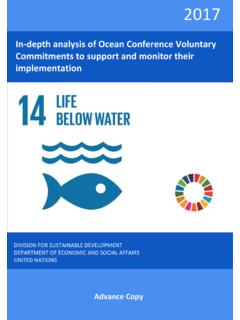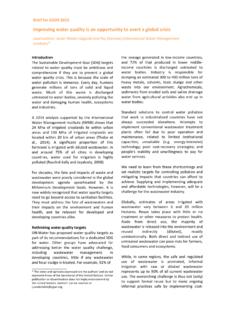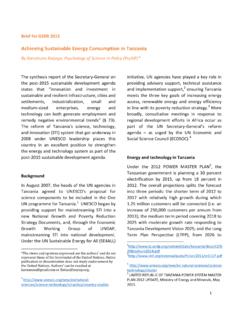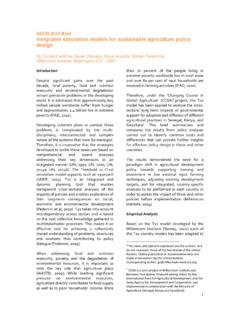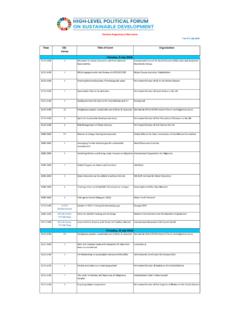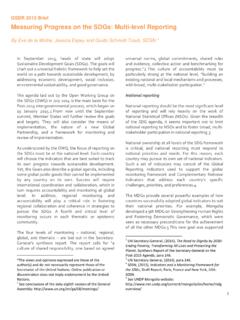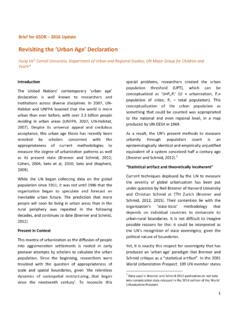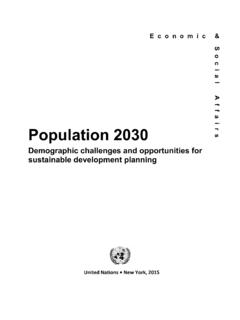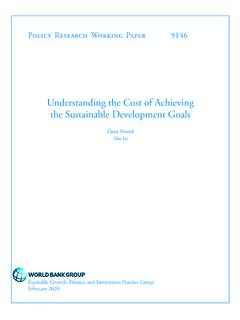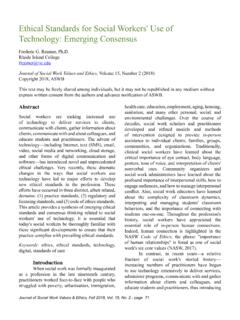Transcription of The Government of the Republic of Zambia - United Nations
1 The Government of the Republic of Zambia The United Nations Conference on Sustainable development June 2012 (Rio+20) May 2012 National Report The United Nations Conference on Sustainable development June 2012 (Rio+20) 2 | P a g e Table of Contents Executive 4 1. INTRODUCTION .. 9 Background .. 9 Objectives and Focus of the UNCSD 2012 .. 9 Purpose, scope and preparation of the national 10 2. INSTITUTIONAL AND POLICY FRAMEWORK FOR SUSTAINABLE development .. 11 Social pillar .. 11 Economic pillar .. 15 Environment pillar .. 20 Legal and institutional framework for sustainable development .. 23 National level .. 24 Sub-national level .. 25 Sector/pillar Specific Institutional Arrangements .. 25 Implementation of national strategies and programmes for sustainable development in Zambia 28 Integration of Economic, Social and Environmental Priorities.
2 28 Wide Participation of Stakeholders .. 29 Country Ownership and Committment .. 30 Comprehensive and coordinated policy process .. 31 Targeting, Resource and Monitoring .. 32 3 PROGRESS TOWARDS SUSTAINABLE development IN 34 Domestication and implementation of relevent international agreements in Zambia .. 34 Multi-lateral Environmental Agreements (MEAS) .. 34 Economic and Trade Multi-lateral and Regional Agreements .. 39 Other Multi-lateral agreements .. 40 Social Protection and Human development Related Multi-lateral and Regional Agreements 40 Conclusions on sustainable development progress in Zambia .. 41 Best Practices .. 44 4 EMERGING ISSUES AND PRIORITIES FOR Zambia ON SUSTAINABLE development .. 46 National agenda for a Green Economy .. 46 Strategies For Poverty Reduction .. 49 Employment creation.
3 51 Potential challenges and constraints .. 52 5 RECOMMENDATIONS .. 55 Combating deforestation .. 55 Responding to climate change .. 55 Reducing Unemployment .. 55 Financing for a Green economy .. 55 Enhace Institutional arrangements .. 56 Mechanism to integrate the 3 SD pillars .. 56 Reporting System .. 56 Appendices .. 58 National Report The United Nations Conference on Sustainable development June 2012 (Rio+20) 3 | P a g e Appendix 1: Terms of Reference (ToRs) .. 59 Appendix 2: Strenghths, weaknesses, opportunities and threats of selected institutions .. 63 Appendix 3: The Extent to which FNDP and Other development Strategies Captured and Implemented the Agenda 21 with Respect to the three Pillars of Sustainable development .. 65 Appendix 4: Social Sustainability Management Plan Lumwana Copper Mine.
4 68 Appendix 5: General Framework used for Assessing Implementation Progress in Sustainable National Report The United Nations Conference on Sustainable development June 2012 (Rio+20) 4 | P a g e Executive Summary Introduction This report summarizes findings of the Zambia Stocktaking Report on the Rio+20 United Nations Conference on Sustainable development (UNCSD) and the Multi-stakeholder Consultative Meeting (MCM) convened in the first week of February 2012 to discuss the Stocktaking Report. The summary focuses on conclusions regarding the extent to which Zambia has implemented Sustainable development (SD) as well as the Agenda 21 and the Johannesburg Plan of Implementation (JPI). In this regard, the summary focuses on conclusions, challenges and recommendations.
5 Conclusions Zambia has made notable progress towards the implementation of Sustainable development (SD). Some of the achievements include: the establishment of the institutional frameworks to facilitate implementation of SD; integration of some aspects of SD into national poverty strategic plans; diversification of the economy away from copper and promotion of sustainable land management. Community driven poverty reduction interventions that incorporate economic, social and environmental concerns at minimum cost have been promoted through interventions such as Food for Assets (FFA) which yield useful results including: community based conservation of wildlife and forests; Conservation Agriculture (CA), and; improved community level production and productivity.
6 However, adequate implementation of SD in the country is still farfetched. SD has not been sufficiently domesticated in the country, and much less at sub-national level. One of the major contributing factors to this gap is the absence of specific institutions mandated at promoting SD at sectoral and national level as well as lack of localized indicators for monitoring progress towards SD. This has resulted in piece-meal implementation of Agenda 21 and progress towards Sustainable development . Major Challenges A number of challenges were noted, that have constrained implementation of SD at the required pace. These include: Absence of an appropriate SD Framework: Whereas a green economy integrates all the major economic and social players whether they be private sector, civil society or Government in production processes that benefit society while at the same time minimizing environmental degradation, a framework to facilitate such an integration does not exist in Zambia .
7 High poverty levels: Since 1992, the country s national poverty level has marginally declined by only percentage points, from 70% in 1991 to in 2010. The poverty situation in the country s rural areas is worse, pausing a great danger to sustainable development given that the livelihoods of many rural poor people is intricately linked with exploiting fragile environments and ecosystems. National Report The United Nations Conference on Sustainable development June 2012 (Rio+20) 5 | P a g e Poor SD Coordination: There is an absence of effective coordination SD mechanism be it at pillar level or otherwise, resulting in lost opportunity to improve cost-efficiency and effectiveness, critical factors due to the country s limited resources. Inappropriate indicators: There is inadequacy of indicators to measure various sustainable development /green economy issues.
8 Most indicators tend to be generic in nature, lacking specificity with regards to issues of Sustainable development . Poor funding of institutions: Though the country has a number of strategic institutions to facilitate implementation of SD, these are poorly funded, resulting in minimal impact on the ground. Other challenges: 1. There has been inadequate domestication of the Agenda 21 in the country, particularly at sub-national level. There has been a gap with regards to specific institutional arrangements mandated to promote and champion the Sustainable development (SD) agenda in the country. 2. There is need for coordinated and consistent SD public awareness campaigns in the country. The awareness campaigns that have taken place so far have lacked consistency, have tended to be fragmented and confined to a few selected sub-sectors and sectors.
9 This has perpetuated low levels of environmental management and Sustainable development literacy. 3. Linked to the above point, there has been inadequate coordination among Government institutions regarding SD issues. Other primary stakeholders outside Government (the civil society organizations and the private sector) have not been sufficiently engaged by Government on SD issues. 4. The use of natural resources in the country has not been maximized. Where such resources have been used, there has tended to be an absence of a well thought through sustainability strategy. 5. There has been an absence of sound legal framework for community control, ownership and active involvement in natural resource management, for instance, with respect to Joint Forest Management, and the limited decentralization and empowerment of communities to manage and benefit from local resources.
10 NGOs have largely been excluded in resource management such as the CRBS under the Zambia Wildlife Authority (ZAWA). 6. The Zambia Environmental Management Agency (ZEMA) though a critical and important institution with respect to the promotion of sustainable development , is merely at a tactical National Report The United Nations Conference on Sustainable development June 2012 (Rio+20) 6 | P a g e level, it fails to engage at a strategic level. ZEMA also fails to engage at the lower level, including community, where implementation issues are prominent. 7. There has been inadequate investment in the country to significantly reduce the high poverty levels, particularly the kind of investment that creates enough jobs and wealth. This has slowed down progress in SD due to the close link between poverty and the exploitation of the environment for livelihoods.
